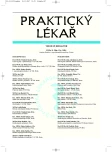Sleep disorders in general practice
Poruchy spánku v ordinaci praktického lékaře
Poruchy spánku tvoří velmi nesourodou skupinu onemocnění. V ordinaci praktického lékaře se nejčastěji setkáme s krátkodobou a chronickou nespavostí. V diferenciální diagnostice musíme zvažovat narkolepsii a idiopatickou hypersomnii, parasomnie REM (abnormní chování v REM spánku) a nonREM (somnambulismus, pavor nocturnus, syndrom neklidných nohou a periodické pohyby dolních končetin ve spánku) a poruchy dýchání vázané na spánek. V článku je podán přehled farmakologické a kognitivně behaviorální léčby poruch spánku.
Klíčová slova:
spánek, hypnotika, antidepresiva, kognitivně behaviorální terapie.
Authors:
L. Závěšická; D. Seifertová
Authors‘ workplace:
Ředitel: Prof. MUDr. Cyril Hoschl, DrSc.
; Psychiatrické centrum Praha
Published in:
Prakt. Lék. 2007; 87(12): 705-711
Category:
Various Specialization
Overview
Sleep disorders are a very heterogeneous group. General practitioners are first in line to encounter patients with acute and chronic insomnia. In differential diagnosis we have to consider narcolepsy and idiopathic hypersomnia, REM and non-REM parasomnias (somnambulism, pavor nocturnus, restless leg syndrome) and apnoeic sleep disorder. The pharmacological and cognitive behavioral therapy of sleep disorders is discussed.
Key words:
sleep, hypnotics, antidepressants, cognitive behavioral therapy.
Labels
General practitioner for children and adolescents General practitioner for adultsArticle was published in
General Practitioner

2007 Issue 12
- Advances in the Treatment of Myasthenia Gravis on the Horizon
- Memantine in Dementia Therapy – Current Findings and Possible Future Applications
- Metamizole at a Glance and in Practice – Effective Non-Opioid Analgesic for All Ages
- Possibilities of Using Metamizole in the Treatment of Acute Primary Headaches
- Hope Awakens with Early Diagnosis of Parkinson's Disease Based on Skin Odor
Most read in this issue
- Functional systems of the human brain
- Laparoscopic cholecystectomy for cholecystolithiasis and its complications. Retrospective 1-year analysis of 411 patients
- Intestinal tapeworms. Do they still exist? Are they still able to surprise us?
- Typical and atypical forms of Celiac disease in adults
